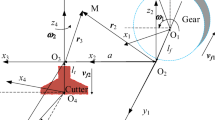Abstract
In this paper, a mathematical model is presented by which the cutting forces in gear form milling process are predicted using the mechanistic approach. To use this approach, a detailed description of the chip geometry is needed. Eccentricity and run-out tool errors are considered, which is of great importance as the chip thickness will by these errors vary for the subsequent cuts. The chip geometry is determined by comparing the path of the cutting edge with already removed material. The boundary of the chips is determinable from the cutting edge geometry, which is here derived in parametric form so spur and helical gears are manufactured correctly. Locally on the cutting edge, the cutting forces are resolved from orthogonal cutting data and on the basis that these forces are proportional to the instantaneous chip thickness. The load each individual cutting tooth experience in operation, as well as the complete load on the tool, are resolved by summing the forces along the cutting edge. In the model, all cut chips are determined for each machined gear tooth gap, with the gear blank boundaries considered. The paper ends with experimental validation using indexable insert milling cutters. It is shown that the model predicts the force shape well and the peak force levels within 12 %.
Similar content being viewed by others
References
Hill R (1950) The mathematical theory of plasticity. Oxford University Press, London
Altintas Y (2012) Manufacturing automation: metal cutting mechanics, machine tool vibration, and cnc design. Cambridge University Press, New York
Özel T, Altan T (2000) Process simulation using finite element method—prediction of cutting forces, tool stresses and temperatures in high-speed flat end milling. Int J Mach Tools Manuf 40:713–738
Svaboda A, Wedberg D, Lindgren L-E (2010) Simulation of metal cutting using a physically based plasticity model. Model Simul Mater Sci Eng 18:1–19
Childs T, Maekawa K, Obikawa T, Yamane Y (2000) Metal machining—theory and applications. New York
Dewhurst P (1978) On the non-uniqueness of the machining process. Proc R Soc Lond A Math Phys Sci 360:587–610
Fang N, Jawahir IS, Oxley PLB (2001) A universal slip-line model with non-unique solutions for machining with curled chip formation and a restricted contact tool. Int J Mech Sci 43:557–580
Hanna NH, Tobias SA (1974) A theory of nonlinear regenerative chatter. ASME J Eng Ind 96:247–253
Kienzle O (1952) Die Bestimmung von Kräften und Leistungen an spanenden Werkzeugen und Werkzeugmaschinen. VDI Zeitschrift 94/11/12:299–305
Jawahir IS, Balaji AK, Baker JR (2003) Towards integration of hybrid models for optimized machining performance in intelligent manufacturing systems. J Mater Process Technol 139:488–498
Ferry WB, Altintas Y (2008) Virtual five-axis flank milling of jet engine impellers—part 1: mechanics of five-axis flank milling. ASME J Manuf Sci Eng 130:011005-1–011005-11
Sun Y, Guo Q (2011) Numerical simulation and prediction of cutting forces in five-axis milling processes with cutter run-out. Int J Mach Tool Manuf 51:806–815
Wan M, Pan W-J, Zhang W-H, Ma Y-C, Yang Y (2014) A unified instantaneous cutting force model for flat end mills with variable geometries. J Mater Process Technol 214:641–650
Wan M, Kilic ZM, Altintas Y (2015) Mechanics and dynamics of multifunctional tools. ASME J Manuf Sci Eng 137:011019-1–011019-11
Vedmar L, Andersson C, Ståhl J-E (2009) A parametric analysis of the undeformed chip geometry in gear hobbing. ASME J Manuf Sci Eng 131:061003-1–061003-8
Ehrmann KF (1990) Grinding wheel profile definition for manufacture of drill flutes. Ann CIRP 39:153–156
Steth DS, Malkin S (1990) CAD/CAM for geometry and process analysis of helical groove machining. CIRP 39:129–132
Häussler U (1999) Generalisierte Berechnung Rämulicher Verzahnung and ihre Anwendung auf Wälzfräserherstellung und Wälzfräsen (In German). PhD thesis, Universität Stuttgart
Andersson C, Andersson M, Ståhl J-E (2011) Experimental studies of cutting force variation in face milling. Int J Mach Tools Manuf 51:67–76
Svahn M, Vedmar L, Andersson C (2014) Gear tooth surface roughness of helical gears manufactured by a form milling cutter. In: International gear conference, vol 1. Lyon, France, pp 96–106
Author information
Authors and Affiliations
Corresponding author
Rights and permissions
About this article
Cite this article
Svahn, M., Andersson, C. & Vedmar, L. Prediction and experimental verification of the cutting forces in gear form milling. Int J Adv Manuf Technol 82, 111–121 (2016). https://doi.org/10.1007/s00170-015-7309-6
Received:
Accepted:
Published:
Issue Date:
DOI: https://doi.org/10.1007/s00170-015-7309-6




